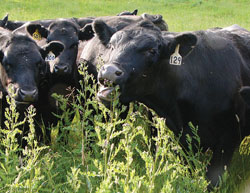 Why spend money on herbicide when you can teach your cattle to eat the weeds? Kathy Voth, owner of Livestock for Landscapes, has a cow-coaching program that will have your cows eating Canadian thistle and other noxious weeds in 10 days or your money back.
Why spend money on herbicide when you can teach your cattle to eat the weeds? Kathy Voth, owner of Livestock for Landscapes, has a cow-coaching program that will have your cows eating Canadian thistle and other noxious weeds in 10 days or your money back.
“When your cows learn to eat the weeds in pastures, you could gain as much as 43 percent more forage,” says Voth. “When cows eat the weeds, you eliminate the expense of weed control and have more feed at no additional cost. Cows gain weight more rapidly on the high protein weeds so you’ll raise more cows more cheaply, and you’ll make more money doing it.”
Voth has researched and worked with livestock as a land management tool for more than a decade. Using what she learned, she invented a process for teaching cows to eat weeds and other non-traditional forages.
Voth has written a book on the subject and produced multiple DVD’s as well. She conducts workshops and presentations, as well as personalized coaching for producers interested in training their cows to eat weeds. Her blog, www.thetaoofcow.com, is full of experiences she has had working with producers and their cows. It also covers many questions she gets, such as concerns about toxic weeds.
Chris Christiaens, Montana Farmers Union, set up a demonstration program in 2011 using Voth’s technique. He taught groups of cattle on three different ranches to eat thistle and other weeds.
“We tried it with one group of 70 head on pasture and two smaller groups of 10 and 15 each in pens,” says Christiaens. “It worked best with the penned groups. When we turned them out with the rest of their herds, the other cows saw them eating thistle, and some of them started eating it too.”
The key to the program was to condition the cattle to eat different feeds, both in taste and texture, for several days. This can be flaked, pelleted or cubed feeds. On the fifth day, Christiaens introduced Canada thistle with hay and later by itself.
“After the fifth day of feeding, we turned them out into the pasture,” he recalls. “They walked through, eating the tips of the thistle at first, then the leaves. Later they came back and ate the stem down to three to four inches in height. It doesn’t kill the thistle, but it guarantees no seed will be produced.”
Voth does personal on-site training . She also offers a remote coaching program. It includes her book and a DVD as well as personal services, including a training recipe for what and how much to feed each day and when to feed it. She contacts a local feed store to find out what’s available and tailors the program accordingly.
Instructions include when and how much of the target weed to gather, how to mix weeds with the training feed, what to expect with the trained cows and how to move them back to pasture.
“I send off the plan and set up a time to review the plan, answer questions and make any needed changes,” says Voth.
Though Voth is available to clients to answer questions by phone every day, she seldom gets more than a few calls. “The calls are more about folks needing a little reassurance they are on the right track,” she says.
Her book and DVD are also available by themselves on her website. A video on Voth’s program can be seen at www.farmshow.com.
While Christiaens had best results with smaller groups, Voth has trained groups as large as 110 cow/calf pairs. She has worked with training in dry lots and on pasture, as well as with cattle of all ages and with bison.
1-800-834-9665
She Teaches Cows To Eat Noxious Weeds
FARM SHOW Magazine » She Teaches Cows To Eat Noxious Weeds
She Teaches Cows To Eat Noxious Weeds
